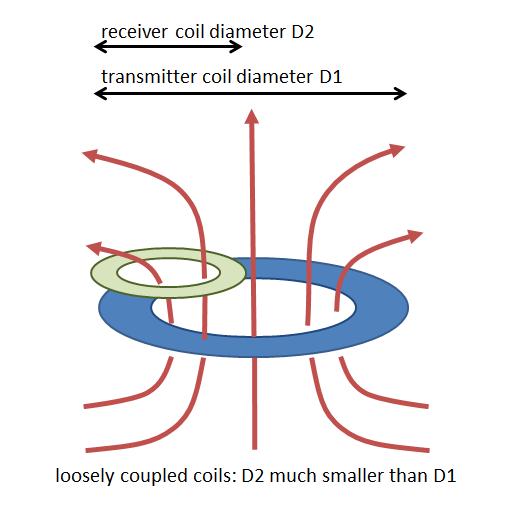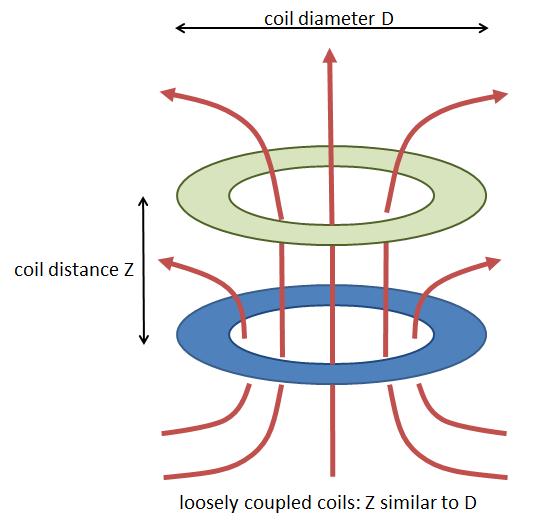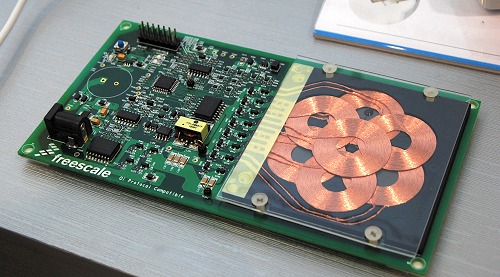The State of Wireless Charging Standards in Mobile
by Andrei Frumusanu on April 2, 2015 8:00 AM ESTInductive Coupling - The Basics
With the history of wireless charging out of the way, the remaining is question is how does it all work? To start, we need to understand the basics of inductive coupling.
Power transfer of inductive coupling happens by creating an alternating magnetic field on the transmitter coil, that magnetic flux is then converted into an electrical current in the receiver coil. The generated electrical current depends on the amount of flux generated by the transmitter coil, and how much of a percentage the receiver coil is able to capture. The distance, size, and positioning of the receiver coil relative to the transmitter coil decides the “coupling factor” of the two coils.
A higher coupling factor means a more efficient power transfer through loss reduction and less heating. In general, we differentiate between tightly coupled and loosely coupled systems.

Source: WPC
In tightly coupled systems, the transmitter and receiver coils both are of the same diameter size and aligned with each other with a minimal distance in-between them. This setup ensures most of the magnetic flux is captured by the receiver coil to be able to be converted into an electrical current.
Loosely coupled systems are defined by setups which do not capture all of the transmitter’s flux, either because the receiver coil distance is too big, or because the coil diameters don’t match and the receiver coil is smaller than the transmitter coil.


Source: WPC
While we mention loosely coupled systems and we’ll get back to them short when investigating Rezence charging, both WPC and PMA standards based on tightly coupled systems.
Optimal alignment of the transmitter to the receiver coil is crucial for a high coupling factor and high efficiency power transmission; because of this, there is a problem of practicality to actually achieve this alignment. To alleviate the issue, Qi transmitters allow for multiple transmitter coils that may overlap.

Source: WPC
By employing multiple transmitter coils over each other, we have a greater area of “optimal coupling” over which a device can be placed on. The control IC of the charging system will then detect which coil is best suited for the power transmission and then use that one for generating the magnetic flux. It is also possible to power on multiple coils simultaneously to achieve a higher power transfer if the receiver device is designed for it.
WPC & PMA Power Control
In Qi and PMA based systems, control over how the coils are powered is done via data communication between the transmitter and the receivers. This is done via data modulation (Either amplitude or frequency based) on the power carrier frequency. The in-band communication requires advanced signal processing and this is where manufacturers’ solution ICs come into play.
WPC wireless power functional diagram, Source: Texas Instruments
This communication is also the main difference and source of incompatibility between the Qi and PMA standards, as without a reliable and interoperable signal the charging process will not start. Powermat differs to Qi by using RFID handshake instead of modulation on the power signal.
The direction of power transfer is always from power transmitter to power receiver. The transmitter idles with in a low power state, which depending on vendor is in the 60mW range. When the power receiver detects a transmitter, it identifies itself to the transmitter as a compliant device and sends configuration information such as the desired charging power. Once power transfer is initiated, the receiver can send error packets requesting more or less power. The power transmission stops upon either receiving an “End Power” message or a period of non-communication of 1.25s.
The coils of a WPC-compliant device operate as resonant half-bridge on a 50% duty cycle with a 19V(±1V) DC power input. Depending on power demand, the frequency in the coil is modulated between 110 and 205 kHz. Powermat on the other hand works in the 277-357 kHz range.
On the receiver side, WPC gives the manufacturers much more liberty in terms of coil-design. While the transmitter is required to have a certain size and provide certain power for standard’s sake, the receiver is allowed to vary in size to adapt to the device form factor the system is implemented into.
Qi in its first low-power specification allows up to 5W of power transfer, with a revision on newer charging systems allowing up to 10W.
Unfortunately PMA does not publicize the standard’s specifications to non-members, so we don’t have any finer details on how it compares to Qi. It’s nevertheless safe to assume that the basic principles of the two standards work in similar fashion.











90 Comments
View All Comments
sonicmerlin - Thursday, April 2, 2015 - link
Witricity tech should allow charging up to a distance of multiple feet.Notmyusualid - Thursday, April 2, 2015 - link
Having the option to charge wirelessly does not prevent you from charging wired, if you need to.I have the option, but if time is short you can bet I'll plug my phone right into the wall...
Dorek - Thursday, April 2, 2015 - link
"2. I can't pick the device up to respond to a text, look at the time, etc without it stopping the charge... this is something I can easily do with the traditional cable method."So? Pick it up for a second, then put it back down. There's no problem with doing that.
"4. It charges slower."
Most tests I've seen online say it's only about another 15 minutes over plugging it in. Big deal.
Gray05 - Thursday, April 2, 2015 - link
I had a wireless charger that came with my Nexus 5 and was pleasantly surprised to receive it. I had only asked for the phone as a gift and not the charger. I had always dismissed wireless charging so here was a free (to me) chance to try it.Not worth the money. In fact, not worth it period.
I can't use my phone while it sits on the puck. I can use my phone while it's plugged into a cord. That distinction is huge. And it always charged slower. WAY slower. The cord is the better way to go until we get wireless charging at distance.
Daniel Egger - Thursday, April 2, 2015 - link
> The cord is the better way to go until we get wireless charging at distance.Wireless charging at distance would be a complete no-go for me: Much higher losses and EM pollution.
blanarahul - Thursday, April 2, 2015 - link
Not mention the tremendous health benefits of wireless charging at distance.Geofram - Thursday, April 2, 2015 - link
When wireless at a distance is out, I'd be the first in line for it. Maybe "right now" it has huge losses, etc, but I wouldn't think it would be released generally unless they could mitigate a lot of that.And I'm highly skeptical of any "health" related issues. We're surrounded by wireless signals, and have been for years. I heard all about how cell phones would give everyone cancer. I'm not ready to label a new kind of wireless power charging bad for us, when it's all theoretical at this point.
My dream would be simple. Walk into your house, your phone, laptop, etc immediately start charging, just like my phone connects to my Wi-Fi. As long as the power inefficiency isn't orders of magnitude worse (aka my power bill quadruples) the convenience would be worth it to me.
sonicmerlin - Thursday, April 2, 2015 - link
It uses magnetic fields to charge electronics. The earth has a far more powerful magnetic field that has no effect on your body.Daniel Egger - Thursday, April 2, 2015 - link
Maybe you'd like to refresh your physics a bit by looking up the difference between a static magnetic field and an electro magnetic field. After that feel free to go ahead and invent the electric generator without moving parts which you've basically just implied. ;)mkozakewich - Thursday, April 2, 2015 - link
It's a distance thing. If you're really really close to it, yes, it'll have a far more powerful effect than the earth's magnetic pull. The earth's magnetics are far more prevalent, though, because it's so massive.It's like gravity. If you go up or down a few hundred metres, you won't notice much. If the earth were a lot smaller (with the same mass but condensed, like a dwarf star), you'd notice a huge amount of gravity at your feet and less near your head.